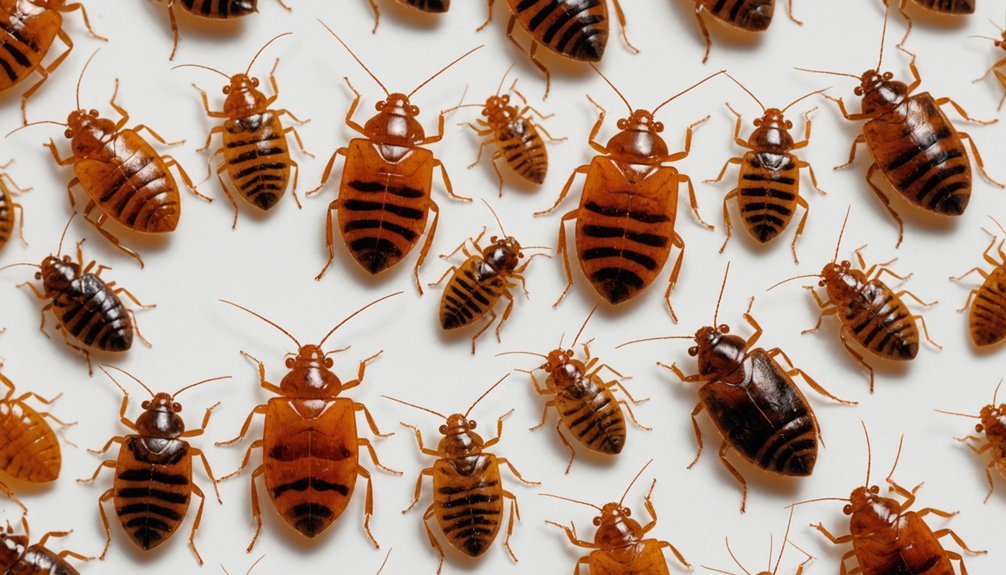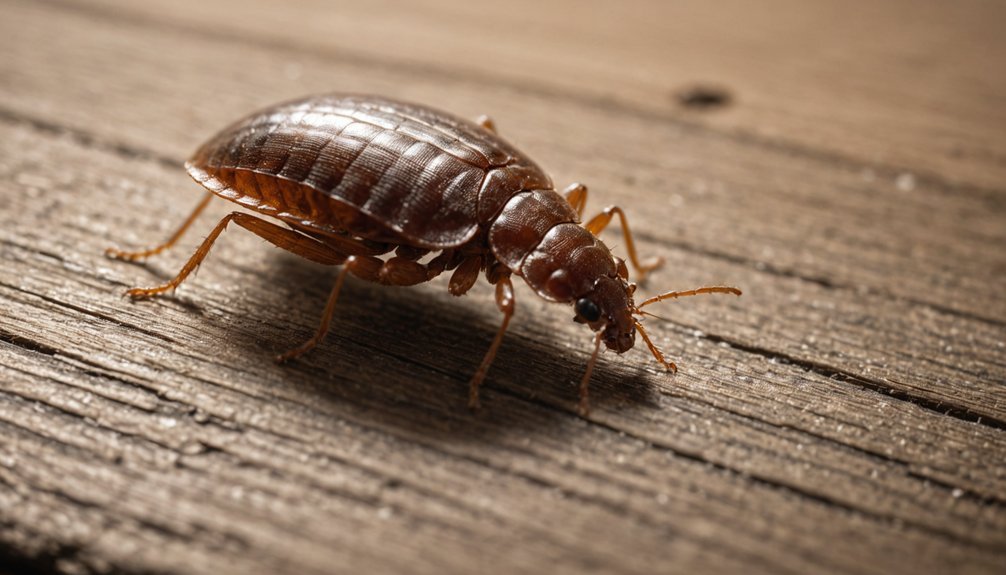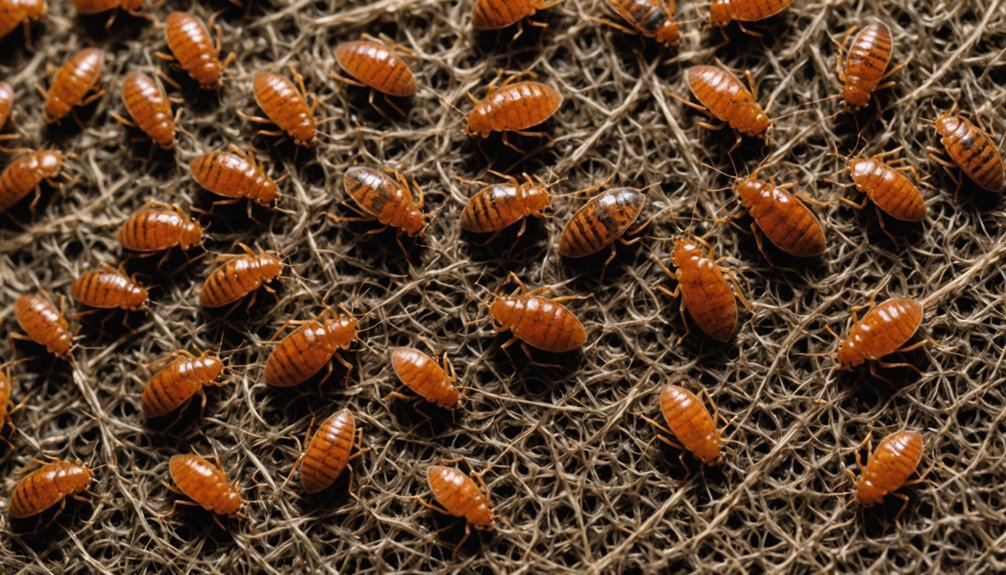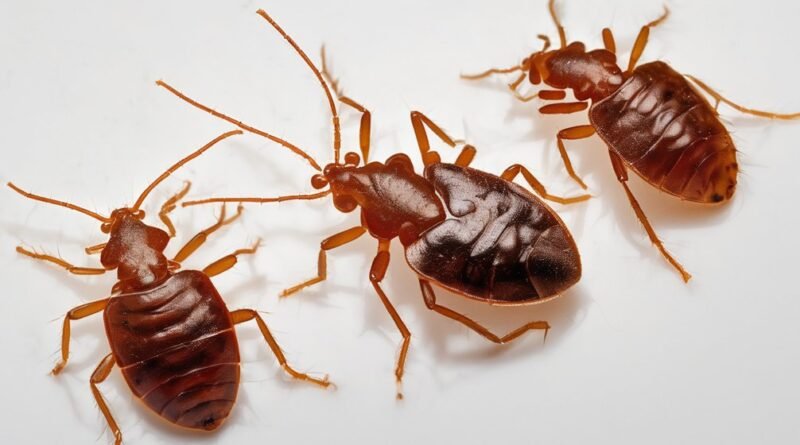Bed Bugs Vs Fleas Vs Ticks: How to Tell the Difference
If you’ve ever dealt with biting pests in your home, you’ll know the frustration of identifying the culprit. While bed bugs, fleas, and ticks may seem similar at first glance, each has distinct characteristics that set them apart. Understanding these differences isn’t just about satisfying curiosity – it’s essential for choosing the right treatment approach and protecting your family’s health. Let’s explore what makes each of these unwanted visitors unique.
Key Takeaways
- Bed bugs are reddish-brown and apple seed-sized (4-5mm), fleas are smaller (1.5-3.3mm) and dark brown, while ticks have eight legs.
- Bed bugs crawl slowly in winding paths, fleas jump impressively high, and ticks wait motionless on vegetation for hosts.
- Bed bugs stay near beds, fleas prefer pet areas, and ticks live outdoors in tall grass and wooded areas.
- Bed bug bites form lines or clusters, flea bites scatter on lower body parts, and tick bites often appear as single spots.
- Fleas are shiny with hard exoskeletons, bed bugs are oval and flat, and ticks have tough, leathery, rounded bodies.
Know Your Enemy: Physical Characteristics

Pests that invade our homes often look deceptively similar at first glance, but knowing their distinct physical traits can help you identify and address an infestation effectively.
You’ll find bed bugs are reddish-brown and apple seed-sized (4-5mm), with flat, oval bodies that swell after feeding. They’ve got six short legs and can’t jump. Their wing pads present make them appear larger, though they are unable to fly.
Fleas are smaller (1.5-3.3mm), dark brown, and laterally compressed, with powerful hind legs for jumping. Their hard exoskeleton appears shiny and smooth.
Ticks, being arachnids, have eight legs (except as larvae) and measure 3-5mm when unfed. They’re distinctively plump and rounded, especially after feeding, with tough, leathery bodies that can be brown or gray.
Their specialized claws help them cling to hosts, while their barbed feeding tube anchors firmly into skin.
Spotting Movement Patterns and Behavior

How these parasites move can tell you exactly what’s infesting your home.
If you’re seeing slow, stop-and-start crawling movements near your bed, you’re likely dealing with bed bugs. They’ll meander in a winding path, especially when searching for a host. Bed bugs can move at speeds of 3 to 4 feet per minute across flat surfaces.
Fleas are the athletes of the group – you’ll spot them making impressive jumps up to 7 inches high and 13 inches across. They move erratically and quickly, making them hard to catch.
These tiny acrobats can leap over 150 times their body length, making fleas some of nature’s most impressive jumpers.
Ticks won’t actively chase you. Instead, you’ll find them in a waiting position called “questing,” where they perch on grass or shrubs with their front legs extended.
When a host brushes against them, they’ll slowly crawl on and attach themselves for several days of feeding.
Where These Pests Make Their Home

You’ll notice distinct home preferences among these three pests, with bed bugs favoring indoor spaces near human sleeping areas, while fleas split their time between animal hosts and nearby surfaces.
While ticks primarily live outdoors in vegetation, waiting to latch onto passing hosts, bed bugs and fleas are more likely to establish permanent indoor residences in your home’s cracks, furniture, and pet areas. Ticks are commonly found hiding in tall grass and woodpiles, making yard maintenance crucial for prevention.
These location preferences directly connect to their hunting strategies, as bed bugs stay close to human sleeping spots, fleas stick near pet resting areas, and ticks quest in outdoor vegetation for passing hosts.
Preferred Living Environments
Understanding where these blood-feeding pests live is essential for effective control and prevention.
You’ll find bed bugs primarily indoors, hiding in mattresses, furniture seams, and headboards where temperatures stay between 65-85°F. These pests are most active during nighttime hours when searching for food.
Fleas thrive both inside and outside, preferring warm, humid spots near where pets rest.
Ticks mostly live outdoors in shaded, humid areas with tall grass.
Host Vs Environmental Hideouts
While all three pests feed on blood, their preferred living arrangements differ greatly.
You’ll find bed bugs hiding near your sleeping areas, only emerging briefly at night to feed. In contrast, fleas prefer to stay on your pets and in their bedding, while ticks primarily live outdoors in tall grass and wooded areas.
- Bed bugs favor mattress seams, box springs, headboards, and nearby furniture cracks – staying close to where you sleep but not on you. Bed bugs detect and move toward human hosts from about three feet away, attracted by body heat and carbon dioxide.
- Fleas remain on pets and in their resting spots, thriving in carpet fibers, pet beds, and upholstery where they can multiply rapidly.
- Ticks attach to hosts for several days of feeding, then drop off into outdoor environments like leaf litter and dense vegetation to complete their lifecycle.
Identifying Bites and Skin Reactions
Distinguishing between bed bug, flea, and tick bites can be challenging, yet each leaves distinct clues through its bite patterns and skin reactions.
Bed bug bites appear as small, red bumps in lines or clusters, often following a “breakfast, lunch, and dinner” pattern on exposed skin during sleep. You’ll find them mainly on your face, neck, arms, and torso.
Bed bugs leave telltale red welts in linear patterns across exposed areas, marking their feeding path as they dine during nighttime hours.
Flea bites scatter randomly on lower body areas, especially feet and ankles, causing immediate itching. They’re marked by red halos and white-topped papules.
Tick bites typically present as a single flat spot, sometimes developing a bull’s-eye rash, commonly found behind ears, in the groin, or behind knees.
While bed bug reactions appear 12-72 hours after being bitten, flea bites itch instantly, and tick bites might go unnoticed until symptoms develop.
Life Cycles and Population Growth
Each of these pests follows distinct life cycles that directly impact how quickly they can infest your home or environment. Understanding these differences helps you anticipate and control potential infestations more effectively.
1. Fleas reproduce most rapidly, with females laying up to 50 eggs after each blood meal and completing their lifecycle in as little as 3 weeks.
They can produce 800 eggs in their lifetime and survive dormant for months.
2. Bed bugs develop more slowly, laying only 1-5 eggs every 6-8 weeks.
While they can produce 200-500 eggs in their lifetime, they need about 5 weeks to reach adulthood and require blood meals at every stage.
3. Ticks have the longest lifecycle, spanning 2-3 years.
Though they lay thousands of eggs, their development is gradual and typically occurs outdoors in wooded areas.
Health Risks and Disease Transmission
While bed bugs primarily cause discomfort and psychological stress without confirmed disease transmission, fleas and ticks pose serious health risks as vectors for multiple dangerous diseases like plague and Lyme disease.
You’ll find that all three pests can trigger allergic reactions and secondary bacterial infections from scratching their bites, but ticks present the highest medical risk due to their extended feeding time and proven ability to transmit life-threatening illnesses.
If you’re dealing with any of these pests, prompt identification and proper treatment are essential, as each requires specific prevention methods and potential medical intervention depending on symptoms and complications.
Disease Transmission Capabilities
Understanding disease transmission among these pests reveals stark differences in their threat levels. Bed bugs rarely transmit diseases to humans, despite lab studies showing they can carry some pathogens.
In contrast, fleas and ticks pose serious health risks as proven disease vectors.
- Ticks are the most dangerous, transmitting multiple severe illnesses like Lyme disease, Rocky Mountain spotted fever, and anaplasmosis through their saliva during feeding.
- Fleas spread serious diseases including plague and murine typhus, while also transmitting cat scratch disease and tapeworms through bites and contaminated feces.
- Bed bugs, though disturbing to find in your home, haven’t been proven to transmit diseases in natural conditions, making them more of a nuisance than a disease threat.
Common Medical Complications
Despite their small size, bed bugs, fleas, and ticks can trigger significant medical complications ranging from mild skin reactions to severe systemic responses.
You’ll typically notice raised, itchy welts from bed bug bites, while flea bites appear as small red marks often grouped in threes. Tick bites usually show localized redness and swelling.
If you’re repeatedly exposed, you may develop increased sensitivity to bed bug bites. You’ll need to watch for secondary infections like cellulitis from scratching any of these bites.
While bed bugs rarely cause systemic reactions, fleas can lead to tungiasis from burrowing sand fleas. Ticks pose the highest risk for severe complications, potentially causing fever, joint problems, and serious diseases like Lyme disease.
In rare cases, any of these parasites can trigger life-threatening anaphylaxis requiring immediate medical attention.
Prevention and Treatment Methods
To effectively combat these parasitic pests, you’ll need a multi-layered approach combining prevention and targeted treatments. Protecting yourself starts with understanding each pest’s unique risks – ticks can transmit Lyme disease, fleas spread diseases like plague, while bed bugs cause skin irritation but don’t transmit diseases.
- Apply EPA-registered insect repellents containing DEET or permethrin when outdoors, and wear long clothing in tick-prone areas.
- Treat your pets year-round with veterinarian-approved flea preventatives while maintaining environmental control through regular vacuuming and washing of pet bedding.
- Prevent bed bug infestations by inspecting hotel rooms and secondhand furniture before bringing items home, and regularly wash bedding at high temperatures (130°F+).
Prevention and Control Methods
Effectively controlling bed bugs, fleas, and ticks requires a multi-faceted approach combining environmental management, chemical treatments, and preventive measures. You’ll need to maintain clean living spaces, use appropriate pesticides, and implement temperature-based solutions. Keep your pets protected with veterinary-approved preventatives and regular grooming.
| Prevention Method | Key Actions |
|---|---|
| Environmental | Trim grass, vacuum regularly, reduce clutter |
| Chemical | Apply acaricides outdoors, use DEET repellents |
| Temperature | Wash items at 130°F, steam clean surfaces |
| Pet Care | Use flea/tick medications, inspect after outdoors |
| Inspection | Check mattresses, furniture, and pets regularly |
Early detection through regular inspections is essential. Look for signs like flea dirt, bed bug stains, or ticks on pets. Remember to seal entry points around your home and avoid tick-prone areas when possible.
Conclusion
You’ll need to be vigilant in identifying these common pests to protect your home and health. Remember that bed bugs are flat and reddish-brown, fleas are tiny jumpers, and ticks have eight legs with rounded bodies. By understanding their unique characteristics, behaviors, and habitats, you can choose the right prevention methods and take swift action when needed.

